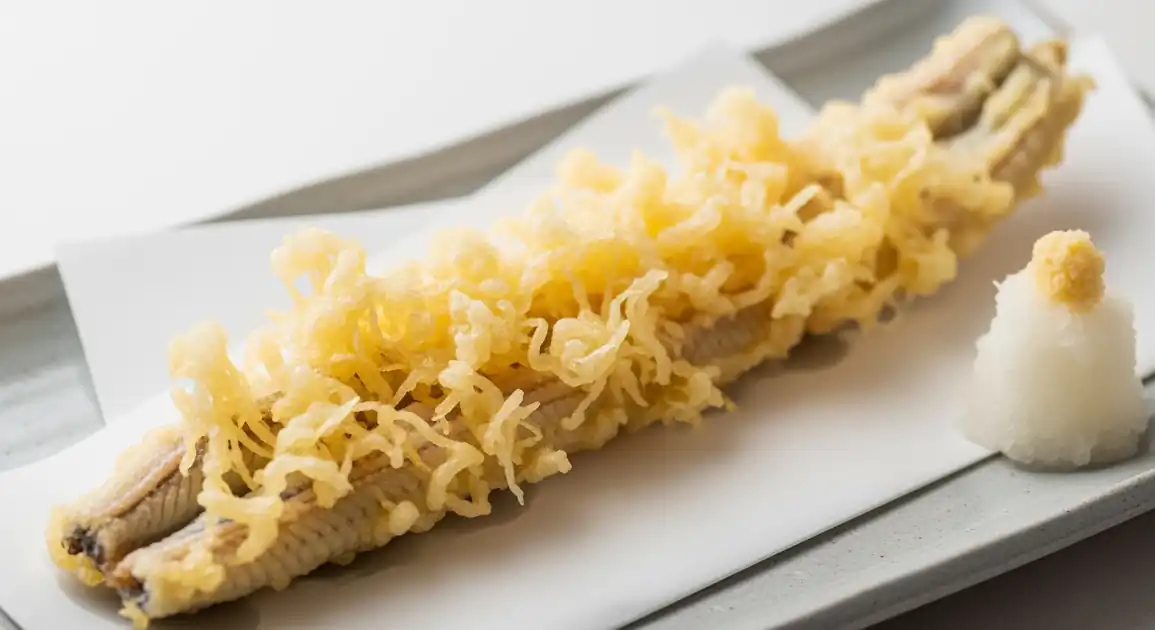Anago Tempura (Conger Eel Tempura)
穴子天ぷら

Description
Tokyo, the heartland of Edomae cuisine, offers some of the best Anago Tempura in Japan. From historic establishments in Asakusa and Ginza to stalls near the former Tsukiji market area, you can find exceptional quality. Anago Tendon is also very popular here.
Dietary Information
Serving information
Serving style
Often served as a star item in tempura courses. Anago Tendon is particularly famous in Tokyo, sometimes featuring a very large fillet covering the entire bowl. Served with tentsuyu/daikon or salt.
Quick facts
Lunch: 11:30 AM - 2:30 PM, Dinner: 5:30 PM - 10 PM. Tendon shops might close earlier.
Safety Tips
What to Look For
-
Fried fresh to order ('Age-tate')
Tempura quality diminishes rapidly after frying. Ensure it's cooked just before serving for optimal crispness and heat, which also ensures thorough cooking.
-
Light, crispy, pale golden batter
Indicates proper frying technique and temperature. Avoid thick, heavy, or dark brown batter, which suggests old oil or incorrect temperature.
-
Clean, clear frying oil
Good tempura shops change their oil frequently. Dark, murky, or smoking oil can impart off-flavors and indicates poor maintenance.
-
Specialty tempura restaurant or counter seating
Places specializing in tempura, especially those where you can watch the chef, usually maintain higher standards of freshness and technique.
-
Served piping hot
Ensures the food hasn't been sitting out and is at a safe temperature, crucial for enjoying the texture.
What to avoid
-
Pre-fried tempura sitting under heat lamps or at room temperature
Will be soggy and potentially unsafe if left out too long. Always insist on freshly fried.
-
Dark, greasy, or overly thick batter
Suggests problems with the oil, temperature, or batter recipe, leading to poor taste and texture.
-
Oil that smells burnt or rancid
A clear sign the oil is old and needs changing. This negatively impacts flavor and safety.
-
Unusually low prices for Anago Tempura
Anago can be expensive. Exceptionally cheap offerings might indicate lower quality eel or preparation standards.
Price information
Price range
Budget tips
- Look for 'Tendon' (tempura bowl) shops for a filling meal under 1500 JPY.
- Lunch sets at high-end Ginza tempura places can be a splurge but cheaper than dinner.
- Stalls near Tsukiji Outer Market sometimes offer single pieces at reasonable prices.
- Avoid tourist traps; look for places favored by locals.
Value indicators
- Long queues at dedicated tempura shops often indicate quality.
- Fluffy, almost translucent Anago meat inside the crisp batter.
- Offered at long-standing 'shinise' (old establishment) tempura restaurants.
- Clearly visible clean oil and skilled chef at counter seats.
Where to Find This Dish
Ginza
Home to many high-end, famous tempura restaurants, often with counter seating.
Ginza Wako Building, Kabuki-za Theatre
Lunch, Dinner
Asakusa
Features several historic tempura restaurants known for traditional Edomae style, including popular Tendon shops.
Senso-ji Temple, Nakamise-dori
Lunch, Dinner
Tsukiji Outer Market
While the inner market moved, the outer market still has eateries, including some offering fresh seafood tempura like Anago.
Tsukiji Outer Market stalls, Namiyoke Shrine
Morning, Lunch (closes early afternoon)
Nihonbashi
Another area with long-standing restaurants, including famous tempura establishments.
Mitsukoshi Main Store, Nihonbashi Bridge
Lunch, Dinner
Vendor Tips
- Reservations are often recommended for popular dinner spots, especially in Ginza.
- For Tendon, observe if they dip the tempura in sauce or provide sauce separately.
- Look for the term 江戸前天ぷら (Edomae Tempura) for traditional Tokyo style.
- Don't hesitate to ask the chef 'Osusume wa?' (What do you recommend?).
How to Order
Regional Variations
-
Edomae Style Anago Tempura
(江戸前穴子天ぷら)
Often emphasizes pure flavors, sometimes using specific sesame oil blends characteristic of the traditional Tokyo style. Preparation might involve specific techniques passed down through generations.
-
Large Format Anago Tendon
(大盛り穴子天丼)
Some Tokyo shops are famous for serving impressively large Anago Tempura fillets that dominate the rice bowl.
-
Anago Shirayaki Tempura
(穴子白焼き天ぷら)
A rarer variation where the Anago might be lightly grilled ('shirayaki' - without sauce) before being battered and fried, adding a subtle smoky dimension.
Cultural context
History
Anago has been consumed in Japan for centuries, particularly prominent in Edomae (old Tokyo style) cuisine, including sushi and tempura. As a common catch in Tokyo Bay, it became a key ingredient for tempura chefs aiming to showcase fresh, seasonal seafood. Its peak season in summer cemented its status as a representative warm-weather tempura item.
Local significance
Anago Tempura is a cornerstone of Edomae Tempura, reflecting Tokyo's history as a fishing hub (Tokyo Bay). Its delicate preparation is seen as a high form of culinary art.
Eating customs
- In Tokyo, using salt is often preferred for high-quality Anago to taste its natural flavor.
- Follow the chef's recommended order if eating a course meal.
- Polite appreciation ('Oishii desu' - It's delicious) is welcomed.